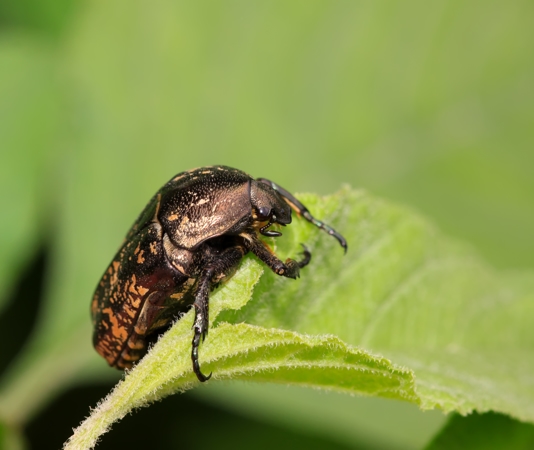What Kinds of Ants Are Invading Your Home?
Ants are one of the most common pests found in homes and yards across the United States. However, each species is different and brings with it numerous challenges and health hazards. Read on to find out more about the ants threatening to invade your home and how the professionals at Pestmaster® can help you stop them.
Argentine Ants
Argentine ants are minuscule black ants native to South America that made their way to the United States in the late 1800s. They are mostly found in the southern and southwestern states. Adult Argentine ants grow from 1/16 to 1/4 inch in length, and range in color from light brown to black. Their bodies are otherwise typical for ants, with six legs, an oval-shaped body, and two 12-segmented antennae.
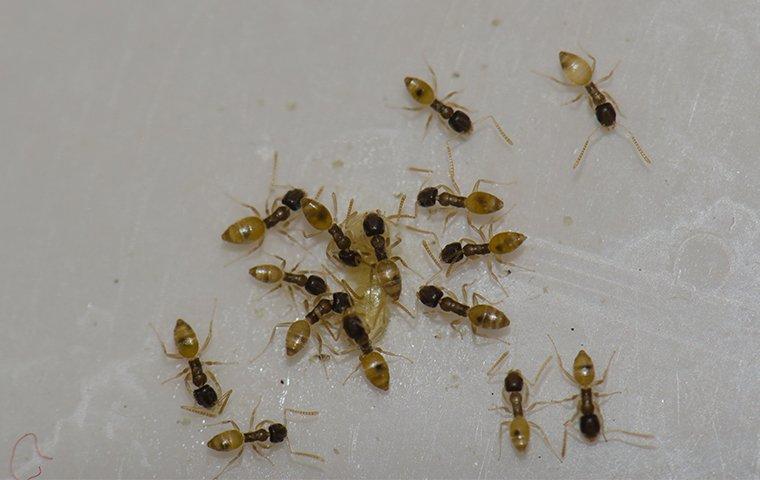
Are Argentine Ants Dangerous?
As they are not known to bite or sting, Argentine ants are generally not considered dangerous household pests. However, like other invasive ant species, this does not stop them from indirectly harming humans in the form of the food they access and contaminate when they invade homes.
Why Do I Have an Argentine Ant Problem?
Argentine ants are known for their extremely large colony sizes. A single colony could have over a million workers bred and overseen by hundreds of queens. These massive colonies are part of the reason why they’ve been able to spread so effectively throughout the U.S. Like other ant species, Argentine ants are attracted to moist environments with access to food.
Outside, Argentine ants are commonly found around the edges of sidewalks and near landscaping. Argentine ant infestations generally occur either when the weather becomes too wet or too dry. Wet weather provides viable sources of food and water outdoors whereas dry weather forces these ants into homes where they can find access to moisture.
Argentine ants typically enter homes through cracks in the foundation or gaps found around exterior windows and doors as they forage for food. Like many ants, Argentine ants prefer to eat sweet foods but will also forage for meats, eggs, oils, and fats found throughout your home. Leaving these types of foods out in the open is a sure way to attract the attention of any Argentine ants that have found their way into your home.
How Do I Get Rid of Argentine Ants?
Due to their excessively large colony sizes and their tendency to invade multiple areas of your home and property simultaneously, Argentine ants can be a difficult ant species to eliminate from your home and property. As with any other ant infestation, your best bet is to contact a professional pest control provider for help.
Pestmaster® has decades of experience eliminating ants found in homes across America using safe and effective methods applied by our expert pest control technicians. If Argentine ants are getting into your home, don’t hesitate to give us a call to find out how we can help.
Carpenter Ants
While having an ant infestation is never a pleasant experience, no ant is worse to have in the home than the carpenter ant. Responsible for hundreds of millions of dollars in property damage every year, carpenter ants are second only to termites in terms of the sheer destruction they cause to the floors, walls, and foundations of the structures they infest.
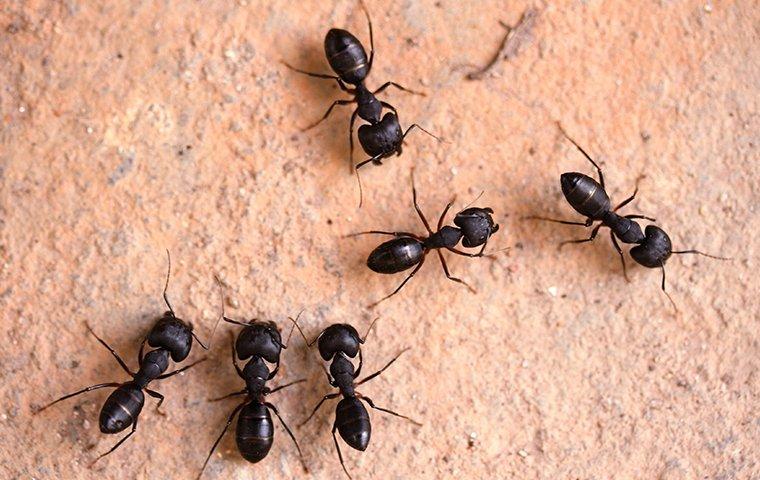
How Do I Identify Carpenter Ants?
Physically, carpenter ants are typically black in coloration, though they can occasionally have a light red or yellow hue. Carpenter ants are generally much larger than other ant species, ranging from 1/8 to 1/2 inch in length.
Carpenter ants are most often seen in the springtime when reproductive members of the colony sprout wings and take flight in mating swarms. During this flight, pairs of male and female carpenter ants will take off in all directions in order to form new colonies. If you see a carpenter ant swarm from your home, it means that you likely have a severe carpenter ant infestation and should contact a professional immediately.
Winged carpenter ants are often mistaken for swarming termites, but they have a few subtle differences:
- Argentine Ants
- Carpenter ants have elbowed antennae whereas termites have beaded antennae.
- Carpenter ants have front wings that are larger than their hind wings. Termites also have two sets of wings, but they're all equal in length.
- Carpenter ants have constricted waists whereas termites' waists are broad.
- Regardless of the differences between termites and ants, if you see a swarm in your home, it's important that you contact a professional pest control service immediately to help you identify the insect species and come up with a treatment solution.
Are Carpenter Ants Dangerous?
Carpenter ants do not present the same direct threats to humans associated with other ant species. Carpenter ants rarely come into contact with humans. On the unlikely chance that they do bite, they are nonvenomous and are generally harmless to people. Their bites pinch, but they will not leave you with the typical painful red bumps that come with bites from other types of ants.
Though they don't directly threaten human health, the damage they cause to structures can pose indirect harm to the people living inside them. Beyond the cost of repairs, extensive carpenter ant tunneling can critically damage your home’s structural fortitude and create potential safety hazards for the people living inside.
Why Do I Have a Carpenter Ant Problem?
Unlike termites, carpenter ants do not actually eat the wood inside your home. Carpenter ants excavate inside structures in order to create galleries where they establish their nests. Even though they don't eat wood, they can still cause extensive damage over time. Each nest they build can house anywhere from thousands to millions of ants, and if left untreated, a carpenter ant problem will quickly become overwhelming.
Carpenter ants must find sustenance somewhere, and if there are carpenter ants on your property, they will likely come inside looking for food and water. While carpenter ants in the wild typically infest dead or rotting wood, your home can provide an ideal nesting alternative, especially if you have rotting or water-damaged wood in your walls or foundations.
However, while carpenter ants prefer moisture-damaged wood, they will also attack healthy wood if it happens to be in the vicinity of their new colony. Ultimately, carpenter ants can attack any home at almost any time, so it’s important to take precautions to prevent them, and if you already have a carpenter ant problem, you should get rid of them as soon as possible.
How Can I Get Rid of Carpenter Ants?
Because their tunneling takes place inside the hard-to-reach areas deep inside your home, carpenter ants are practically impossible for most homeowners to treat or defend on their own. Luckily, the professionals at Pestmaster® Services can treat any carpenter ants that may have come onto your property, destroying all the colonies and keeping your biggest investment protected for the future.
Fire Ants
Fire ants are an extremely aggressive ant species and are notorious for their painful stings. They will sting any person or pet that comes into contact with them. Fittingly, fire ants get their name equally from their reddish-brown coloration and from the burning sensation that they leave behind on their victims. Fire ants are typically 1/10 to 1/4 inch long.

Where Will I Find Fire Ants?
Fire ants are common across all of the United States, though they are especially numerous in the southern areas of the country. In the summertime, fire ant hills can be hard to avoid in lawns across the country.
Fire ants aggressively build their nests and defend them from threats by viciously attacking and stinging anyone who happens to step on one.
While they are commonly found outdoors, fire ants are also known to make their colonies inside hollow doors or wall voids inside homes.
Are Fire Ants Dangerous?
While fire ants can bite, their notoriety comes from the burning stings they give to people that come into direct contact with them. Fire ants have a stinger on their abdomen that injects venom into their victims. While a sting from one ant is painful, fire ants’ strength comes from their numbers, and being stung by several at once can be dangerous or even deadly, especially for those with allergies.
In the wild, fire ants can overwhelm and attack small animals. They are also known to feed on plants and crops, which can wreak havoc on farms. Inside homes, fire ants also pose an indirect threat to the people inside due to their tendency to chew on electrical wires and insulation. Beyond property destruction, this behavior can lead to catastrophic results such as house fires.
Why Do I Have a Fire Ant Problem?
In the springtime, pairs of reproductive ants grow wings and create mating swarms, each pair flying off in different directions to form new colonies with the female reproductive ant becoming the new queen. If fire ants happen to swarm near your home, don’t be surprised if you start seeing your yard covered in fire ant hills practically overnight.
Many homeowners bring fire ants into their own yards and homes by accident. If you’ve recently brought new plants from a nursery into your garden or inside your home, fire ants may be hiding inside. Furthermore, during the transportation of new plants, they may find their way into your car and wind up nesting in your garage.
Fire ants prefer to nest in open areas with lots of moisture, which perfectly describes many yards across America during the spring and summer months when temperatures soar and humidity is high. If your home is accessible and can provide food and water resources, don’t be surprised if fire ants quickly find their way from your yard to your kitchen.
How Do I Get Rid of Fire Ants?
Fire ants are simultaneously territorial and aggressive. They will also expand their colony quickly turning a small fire ant problem into a large one in a small amount of time. These factors make them incredibly difficult to prevent for the average homeowner. If prevention fails, completely treating an ant infestation on your own can be next to impossible.
Don’t leave the health and safety of your home and yard to chance. Contact the professionals at Pestmaster® Services to discuss our comprehensive ant treatment program. Our expert technicians will use the latest and greatest eco-conscious pest reduction techniques to help you take back your yard and keep it ant-free for the future.
Little Black Ants
Little black ants are one of the most common household invaders found in kitchens across the United States. They appear exactly as their name suggests: small, at only roughly 1.5mm (.06 inches) long with black coloration and a two-segmented waist. Little black ants are native to the United States, and, like other ant species, they are social insects that live in large colonies. Little black ants typically swarm from June to August, during which time reproductive ants will pair off in mating flights, flying in separate directions and forming colonies of their own.
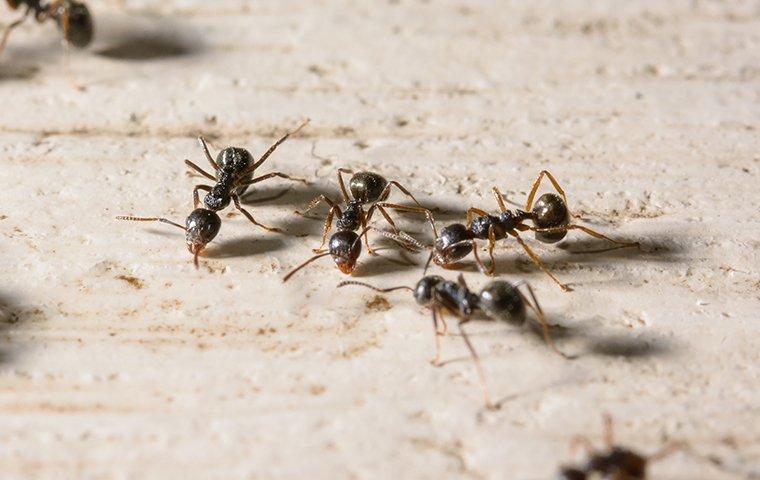
What Do Little Black Ants Eat?
Little black ants are omnivorous and will eat almost anything they can find, which generally includes sweets, fruits, vegetables, plant secretions, grease, and other insects.
Most homeowners have probably witnessed little black ants making trails along kitchen counters or windowsills as they make their way back and forth between a food source and their colony.
Are Little Black Ants Dangerous?
Little black ants are not considered dangerous. While they have both biting mandibles and a stinger, their small size prevents them from having any noticeable effect on humans. However, they are still considered a nuisance due to their tendency to invade homes and get into food items.
Why Do I Have a Little Black Ant Problem?
Outdoors, little black ants generally nest in rotting logs, in grass lawns, and in the cracks of cement. When foraging for food, they will enter homes through small cracks and crevices in foundations, exterior walls, and around windows and doors. Once one ant gets inside, it will leave a pheromone trail for other ants to follow. Before long, the ants will create new nesting areas inside your home.
Like any other pest, little black ants primarily enter homes in search of food and water resources. While they may be small, their size allows them to squeeze into even the smallest cracks or gaps in your home’s foundation, walls, or flooring. Once inside, they will invade your kitchen, bathroom, and other areas of the home in search of food and water.
How Do I Get Rid of Little Black Ants?
Preventing such a small pest from getting into your home and treating the infestation once it becomes a problem can be a daunting task for any homeowner. You don’t have to do it alone; if little black ants are causing you big problems, contact the professionals at Pestmaster® for help. We will work with you to come up with a solution to your ant problem.
Odorous House Ants
Odorous house ants are a common invasive ant species found across the United States. These ants are small and brown or black in color. They are a smaller ant species reaching about 1/8 inch in length. Odorous house ants are named for the foul odor they give off when crushed or stepped on.
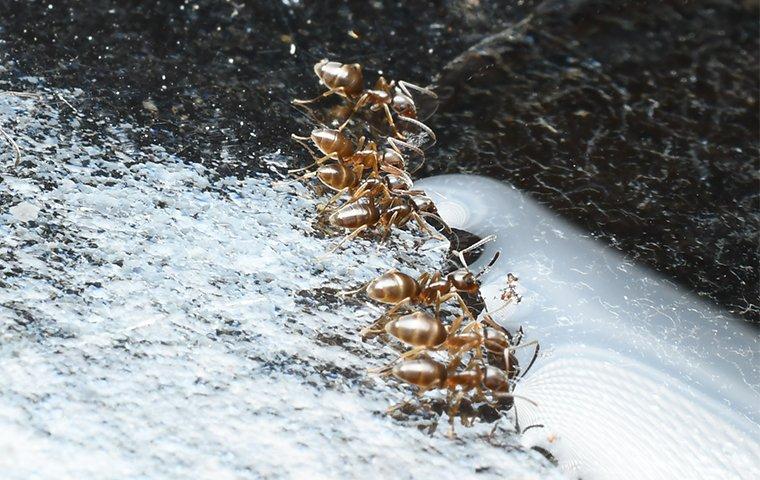
What Do Odorous House Ants Eat?
Odorous house ants primarily subsist on honeydew to survive and are generally attracted to homes that have aphids and other scale insects nearby that produce their favorite food source.
They also will invade homes in search of water and sweets. Therefore, it is important to clean up crumbs, store pantry items in sealed containers, repair leaky pipes, and resolve any moisture issues.
Are Odorous House Ants Dangerous?
Odorous ants are considered a nuisance pest because of the unpleasant odor they leave behind. These ants are not harmful to human health. They can bite like other ants, but they generally do not bite people. Furthermore, their small size and lack of venom mean that even if you are bitten, it won’t hurt very much.
However, while they don’t generally cause direct harm to humans or pets in homes they infest, they can indirectly harm them by contaminating food items. They seek out sugary foods found in any home they inhabit, and their small size allows them to squeeze into the smallest holes and cracks to access a viable food source.
Why Do I Have an Odorous House Ants Problem?
Like any other pest, odorous house ants invade homes primarily in search of food and water in order to survive. These ants are also known to invade during periods of heavy rainfall in search of a warm, secure place to stay until the weather improves.
While they can get inside through open windows or doors, they can also gain access through small cracks in your home’s foundation. Odorous house ants are known to target homes with moisture problems where water is easily available.
How Do I Get Rid of Odorous House Ants?
As with any invasive ant problem, the only guaranteed way to eliminate the problem is through a comprehensive pest treatment program from a licensed and certified pest control provider. If odorous house ants are making a stink around your home, contact Pestmaster® today to find out how we can help.
Pavement Ants
Pavement ants are one of the most common types of ants found in urban and suburban habitats. Pavement ants range in color from dark brown to black, growing to about 1/8 of an inch long, though queens can grow significantly larger. They have antennae with 12 segments. One of their antennae has 3 segmented clubs on the end. They are distinguishable by the parallel grooved lines that run down their bodies from head to thorax along with the spines that protrude from their thoraxes.
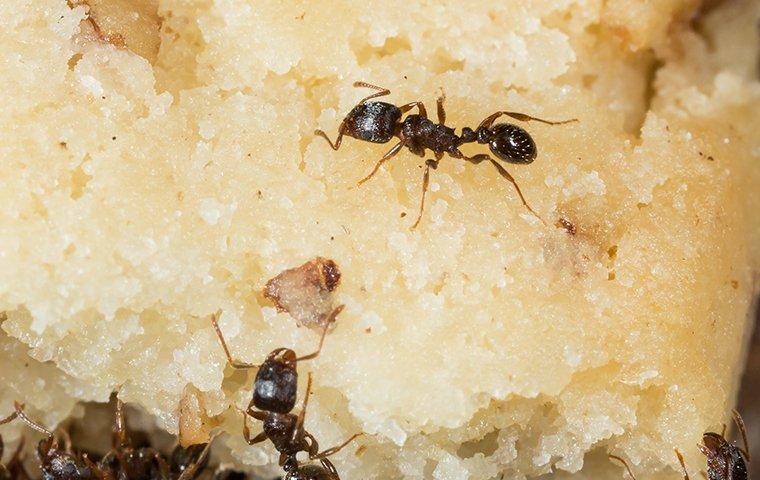
Where Will I Find Pavement Ants?
Pavement ants are named for where they’re primarily found: on sidewalks, in the cracks of driveways, and around other concrete structures. As foragers, they are excellent at getting into cracks and expansion joints found in slabs.
Are Pavement Ants Dangerous?
Pavement ants are not considered to be a dangerous ant. While they can both sting and bite, pavement ants are a comparatively docile species of ant that are non-aggressive and rarely come into direct contact with humans.
On the other hand, while they pose little direct threat, they are a considerable nuisance pest and can pose an indirect threat through the food items they invade and contaminate. If they find their way into your home, pavement ants will feed on meats, grease, nuts, and cheese.
Why Do I Have a Pavement Ant Problem?
Pavement ants are typically found living outside forming nests along sidewalks. In their quest for food and water, they will make their way to the concrete foundations of homes and create nests underneath flooring or in insulation found behind walls.
How Do I Get Rid of Pavement Ants?
Pavement ants are a difficult pest to get rid of because of the large number of ants present in their colony and their ability to get into areas of the home that are typically out of reach to the average homeowner. Luckily, the team at Pestmaster® has all the tools and know-how necessary to prevent and eliminate any pavement ant infestation. If you have pavement ants on your property, contact us today to discuss our comprehensive ant control plan.
Have an ant problem? Pestmaster® has the solution. Contact us today to learn more about how we can help.
.png)

